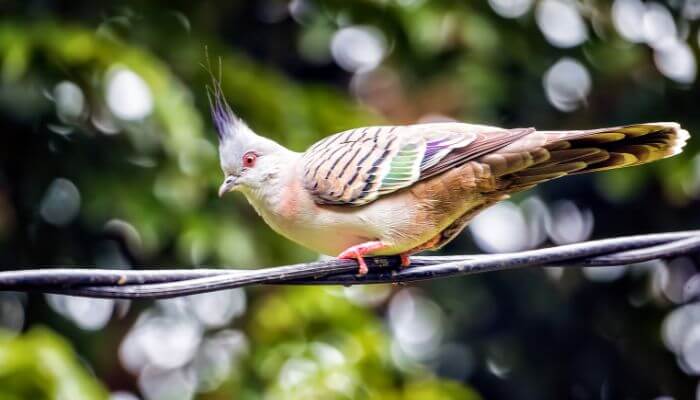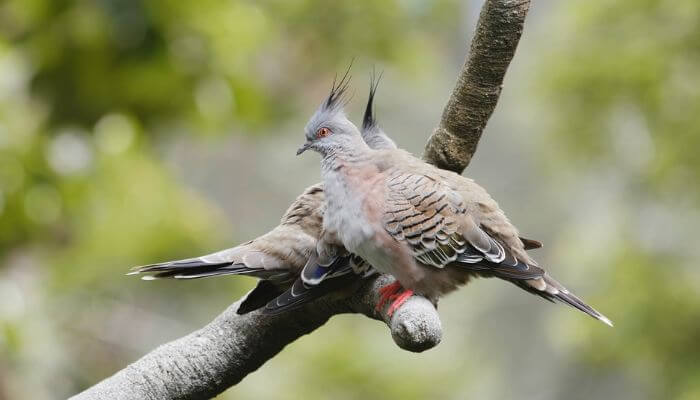The crested pigeon, Latin name Ocyphaps lophotes, is one of the native species of Australian pigeons.
It gained its taxonomical classification and binomial name in 1822 from Dutch zoologist Coenraad Jacob Temminck.
It is known for its distinctive head crest and is widespread across much of the continent.
Origins of the Crested Pigeon
As a native species, the crested pigeon’s closest relatives are the spinifex pigeon and the flock bronzewing pigeon.
It shares some bodily characteristics with the flock pigeon but it shares the honor of being one of only two pigeons with a head crest, the other being the spinifex.
The crested pigeon is larger than the spinifex.
The earliest known scientific description of a crested pigeon date back to 1801, made by English naturalist John Latham on a specimen that was collected in New South Wales.

Distribution And Habitat of the Crested Pigeon
The crested pigeon can be found across most of the Australian continent except for the far northern tropical areas.
The range of the species extends all the way from Queensland to Western Australia, and from the central desert to the southern coasts.
The crested pigeon is primarily a species that dwells on the ground so you will not find it in densely forested areas or very arid regions. It is mostly found in savannas, grasslands, open woodlands and other wide agricultural areas but always quite close to a water source.

The species will commonly be seen in places like gardens, parks and other open urban areas.
The crested pigeon is not a migratory bird and do not take undertake any large-scale seasons movement to different locations over the year. They maintain relatively stable ranges throughout the year, only moving in response to changes in water and food availability.
Status of the Crested Pigeon
As of 2023, the created pigeon is listed by the Union for Conservation of Nature (IUCN) as being of ‘Least Concern’. What this means is that the species is not deemed to currently be facing any major or significant threats to its population.
At its last assessment in 2016, an increase in population was recorded.

Appearance of the Crested Pigeon
| Wingspan | Length | Weight | Coloring | |
|---|---|---|---|---|
| Crested Pigeon | 40 – 45 cm | 30 – 34 cm | 150 – 250 g | Grey with tinges of brown and green and black head crest |
| Average Feral Pigeon | 64 – 72 cm | 32 – 37 cm | 300 – 500 g | Bluish grey with some black |
The crested pigeon is a medium-sized bird, with adults able to grow up to 34cm in length and up to 250 grams in weight.
The main plumage is pale dove grey with a brown tinge but it has some wonderfully colored areas.
The sides of the breast and neck are rose-pink, the vent is a grey-buff, under tail coverts are darker grey and the underwing coverts are white.

The flight feathers are grey and there is distinctive black barring on the wing coverts and scapulars.
Also on the wings are iridescent feathers of glossy metallic purple and green with prominent white fringes.
The tail is long and pointed in grey-brown with a broad white tip.
Most distinctively, their soft grey heads are adorned with a small, very erect crest of grey feathers with black tips that gives them their name.
The eyes are yellow-orange with a pinkish eye ring, and the beak is small and black with grey base and cere.
Their coloration is finished off with legs and feet that are a pinkish red!
Both sexes are very similar in appearance.
The crested pigeon sometimes gets called the topknot pigeon but this species has a very different head decoration and not the erect tufted crest of the crested and spinifex pigeons.
Crested Pigeon Character
The crested pigeon is considered to be a social bird, often forming flocks that can number in the hundreds or even thousands.
Gregarious birds, in their flocks, they communicate with one another using a range of different calls and vocalizations.
Their advertising call is a soft and plaintive cooo-oo (as can be heard in the sound file below) that can become a loud coo-wooo with a raised pitch in the middle.
Mating displays are accompanied by a shorty grunting oo.
A single whoop signifies their alarm call.
Like many other members of the Columbidae family, the crested pigeon’s wings make a whistling sound when it takes flight.
Its flight is of rapid wing beats alternated with fast glides.

Diet of the Crested Pigeon
This is a granivorous species and first choice food sources include grasses, shrubs, herbs, fallen seeds and grains.
Crested pigeons will also eat fruits from the native and exotic trees, as well as small invertebrates and insects that can provide protein and other nutrients.
Farmers quite like crested pigeons because although they are partial to their seeds, they also feed on the invasive weed Echium plantagineum (Patterson’s Curse) which is poisonous to grazing livestock.
Crested Pigeon Mating And Breeding
The breeding season of the crested pigeon is the warmer months, September to March.
They build a delicate nest of twigs in dense thorny foliage, usually between 1 to 5 metres above the ground.
During the breeding season, the male performs flight displays. He’ll fly into the air at a steep angle with strong beats of loudly clapping wings. It will glide down in a curve with wings open to land on a perch.

The male also performs bowing displays. It approaches the female with raised wings to show off its glossy patches, and it raises and spreads its tail. Then, it bobs up and down rapidly, flexing its legs and uttering its display call “oo”.
This species produces several broods per year, and males may have several different mates in a single season.
A pair of pigeons build the nest together and the female lays 2 to 3 eggs that get incubated by both parents for around 17 to 20 days.
Once hatched, the chicks are fed crop milk by both parents.
The chick will stay in the nest for two to three weeks being fed by the parents.
Taking Care Of Crested Pigeons
Being a wild pigeon species, the best thing that you can do to help with the care of the crested pigeon is to commit to keeping their preferred habitats in good condition, giving them the best-continued chance to thrive and multiply!
